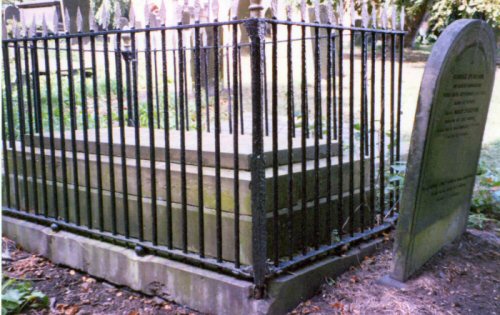

EBENEZER ELLIOTT
(1781 - 1849)
The Elliott Family Graves
The graves of the Elliott family are situated in Rotherham and in Darfield, both in Yorkshire. In both cases, the graves are in the yards of churches called All Saints. Darfield (not far from Barnsley) was the burial place of the Corn Law Rhymer & his wife. There are two further graves there: one contains several of the bard's offspring (as shown later in this article) while the other grave is that of John Watkins who married the poet's daughter. The Rotherham grave is older & was in use from 1783 to 1815.
THE ROTHERHAM GRAVE
The Elliott family grave is in the minster church of All Saints in the town centre of Rotherham. The grave has been placed flat on the ground & is situated on the grass bank above All Saints Square. The inscription on the grave is shown below, followed by a few explanatory notes.
The Corn Law Rhymer moved his family to Sheffield in 1819 in order to make a new beginning after his Rotherham bankruptcy, but all three children born after the move were still taken back to Rotherham for their christenings; thus Elliott displaying a strong attachment to his native town. Ebenezer Elliott (senior) was not buried in the family's Rotherham grave. The bard's father died in 1822 aged 74, three years after his son moved to Sheffield. Elliott (senior) died at Smithy Place near Holmfirth. As his wife, Ann/Nancy, had died seven years earlier, we can suppose that relatives looked after him in his final years.
THE DARFIELD GRAVES
The family graves in All Saints Church at Darfield are to the right of the church. That of the Corn Law Rhymer and his wife Fanny Ann is surrounded by railings which survived the second world war when other railings were taken down to be used in the war effort.
The Corn Law Rhymer died aged 68 in 1849 & was buried in the grave (see opposite) at Darfield. Later, his wife Fanny was interred beside him. Fanny had been christened Frances Garside in April 1781, born the same year as her husband. Coming from Cumberworth, Denby Dale, Fanny married the Corn Law Rhymer at Penistone Church in 1806. According to William Howitt, the writer & journalist, Fanny was an impressive person: "Mrs Elliott, a tall, good-looking woman, I soon found as lady-like, sensible, and well-informed as any poet could desire for his companion."
There were 3 other children who were not buried in the above grave. Clearly their deaths had occurred before that of their father which explains the reason for them being buried elsewhere. The children were: William (born Aug 20th 1812), Charles ( born Feb 1st 1814) and Thomas (born July 27th 1818).
The final Darfield grave is placed next to the Corn Law Rhymer's. Two views of it are shown below. John Watkins,"late of London" died in Sheffield on Sep 22nd 1850 less than a year after marrying the bard's eldest daughter, Fanny Ann. The latter died 49 years after her husband who was only 41 when he died.

Two views of the Darfield graves. On the left is
that of Fanny Ann Watkins (nee Elliott) with her father's tomb in the
background behind the railings. The right hand view shows John Watkins'
inscription. (Watkins was the Chartist poet
& playright, whose biography of the Corn Law Rhymer was published
in 1850. The grave also contains the body of the couple's daughter,
Clarens Fanny Watkins who died in 1882 (aged 31 or 32). Clarens married
name was Murray - her husband, Lewis Murray, was buried at Ecclesall,
Sheffield).
In studying the family graves, it is noticeable how young some people were when they died and also how the same names are used generation after generation. The most pertinent example is Ebenezer, where three generations used the name: the Corn Law Rhymer's father, the Corn Law Rhymer himself & the latter's son. Ann is another good example and so is Fanny.
To return to
Ebenezer Research Foundry, please strike the anvil 